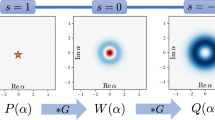Abstract
The generalization of the arbitrary concept of sign to N-dimensional mathematical objects is discussed. Basically, the main argument employed here is founded in the previously described concepts of vector semispaces and their organization in shells. Usual operations in vector spaces are complemented by the inward matrix product, a matrix and vector product present within high level programming languages, as a sustentation of generalized signatures. It is shown how any vector space can be simply constructed from a simple set of convex positive definite mathematical objects. The sign generalization described here permits the definition of sign multiplets and signature support groups as a first step of deepening into the concept of general sign structures, which can be considered as possible conventions, situated far away from the classical Boolean sign structure. One can conclude that the study and use of sign generalization still is far to be complete. The theoretical set up developed in this way can be easily introduced in quantum chemistry wave function and density analysis.
Similar content being viewed by others
References
R. Carbó-Dorca, Tagged sets, convex sets and QS measures, J. Math. Chem. 23 (1998) 353–364.
R. Carbó-Dorca, Fuzzy sets and Boolean tagged sets; Vector semispaces and convex sets; Quantum similarity measures and ASA density functions; Diagonal vector spaces and quantum chemistry, in: Advances in Molecular Similarity, Vol. 2, eds. R. Carbó-Dorca and P.G. Mezey (JAI Press London, 1998) chapter 2.
L.A. Zadeh, Fuzzy sets, Inform. Control 8 (1965) 338–353.
R. Carbó-Dorca and E. Besalú, A general survey of molecular quantum similarity, in: Huzinaga Symposium, Fukuoka, available at J. Mol. Struct. (Theochem) 451 (1998) 11–23.
R. Carbó-Dorca and E. Besalú, Quantum theory of QSAR, Contributions to Science 1 (2000) 399–422.
R. Carbó-Dorca, Ll. Amat, E. Besalú, X. Gironés and D. Robert, Quantum molecular similarity: Theory and applications to the evaluation of molecular properties, biological activities and toxicity, in: Fundamentals of Molecular Similarity, eds. R. Carbó-Dorca, X. Gironés and P.G. Mezey (Kluwer Academic/Plenum Press, New York, 2001) chapter 12.
R. Carbó-Dorca, E. Besalú and X. Gironés, Extended density functions, Adv. Chem. 38 (2000) 1–63.
R. Carbó-Dorca, D. Robert, Ll. Amat, X. Gironés and E. Besalú, Molecular Quantum Similarity in QSAR and Drug Design, Lecture Notes in Chemistry, Vol. 73 (Springer, Berlin, 2000).
R. Carbó-Dorca, Quantum quantitative structure-activity relationships (QQSAR): a comprehensive discussion based on inward matrix products, employed as a tool to find approximate solutions of strictly positive linear systems and providing a QSAR-Quantum Similarity Measures, in: Proc. ECCOMAS 2000 (CIMNE, Barcelona, 2000).
R. Carbó-Dorca, Ll. Amat, E. Besalú, X. Gironés and D. Robert, Quantum molecular similarity: Theory and applications to the evaluation of molecular properties, biological activities and toxicity, in: Fundamentals of Molecular Similarity, eds. R. Carbó-Dorca, X. Gironés and P.G. Mezey (Kluwer Academic/Plenum, New York, 2001) pp. 187–320.
C. Roos, T. Terlaky and J.-P. Vial, Theory and Algorithms for Linear Optimization (Wiley, New York, 1997); R.A. Horn and Ch.A. Johnson, Matrix Analysis (Cambridge Univ. Press, Cambridge, 1985).
I.M. Vinogradov (ed.), Enciclopaedia of Mathematics, Vol. 4 (Kluwer, Dordrecht, 1989); A Fortran 95 connection: LF95 Language Reference (Lahey Computer Systems, Incline Village, NV, 1998), see also http://www.lahey.com.
R. Carbó-Dorca, Inward matrix products: extensions and applications to quantum mechanical foundations of QSAR, J. Mol. Struct. (Theochem) 537 (2001) 41–54.
R. Carbó-Dorca, Density functions and generating wave functions, Institute of Computational Chemistry, Technical Report IT-IQC-01-nn, University of Girona (2001).
R. Carbó-Dorca, Shell partition and metric semispaces: Minkowski norms, root scalar products, distances and cosines of arbitrary order, Institute of Computational Chemistry, Technical Report IT-IQC–02–18, University of Girona (2002), to appear in J. Math. Chem.
I.M. Vinogradov (ed.), Encyclopaedia of Mathematics, Vol. 8 (Kluwer Academic, Dordrecht, 1992).
R. Carbó and E. Besalú, J. Math. Chem. 13 (1993) 331–342; Comput. Chem. 18 (1994) 117–126; J. Math. Chem. 18 (1995) 37–72; Applications of nested summation symbols to quantum chemistry: Formalism and programming techniques, in: Strategies and Applications in Quantum Chemistry, eds. Y. Ellinger and M. Defranceschi (Kluwer Academic, Dordrech, 1996) pp. 229–248.
R. Carbó-Dorca and E. Besalú, Fundamental quantum QSAR equation: extensions, nonlinear terms, and generalizations within extended Hilbert-Sobolev spaces, Int. J. Quantum Chem. 88 (2002) 167–182.
D. Bohm, Quantum Theory (Dover, New York, 1979).
R. McWeeny and B.T. Sutcliffe, Methods of Molecular Quantum Mechanics (Academic Press, London, 1969).
A. Jeffrey, Handbook of Mathematical Formulas and Integrals (Academic Press, New York, 1995).
K. Fukui, Theory of Orientation and Stereoselection (Springer, Berlin, 1975).
R. Carbó-Dorca, Applications of inward matrix products and matrix wave functions to Hückel MO theory, Slater extended wave functions, spin extended functions and Hartree method, Institute of Computational Chemistry, Technical Report IT-IQC–22–01, University of Girona (2001), to appear in Int. J. Quantum Chem.
Author information
Authors and Affiliations
Rights and permissions
About this article
Cite this article
Carbó-Dorca, R. About Some Questions Relative to the Arbitrariness of Signs: Their Possible Consequences in Matrix Signatures Definition and Quantum Chemical Applications. Journal of Mathematical Chemistry 33, 227–244 (2003). https://doi.org/10.1023/A:1024742724706
Issue Date:
DOI: https://doi.org/10.1023/A:1024742724706



